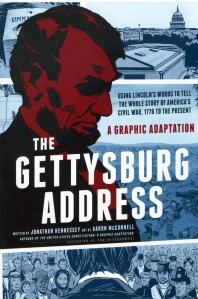The holiday gift guide continues! Here’s one for the history buff in your life. Or the reluctant reader. Or the pot head who rails on and on about states rights vs federal authority.

Hennessy, Jonathan. The Gettysburg Address: A Graphic Adaptation. Illus. Aaron McConnell. New York: William Morrow, 2013. Print.
Genre: Nonfiction Graphic Novel
Summary: Hennessy and McConnell use the innovative and fast-moving format of the graphic novel mode to tell the story behind the Gettysburg Address, what prompted it, what it changed, and why it mattered to America and the world.
Critique: The cover of this book claims to retell this moment of history through Lincoln’s words. I was immediately drawn in because Lincoln is one of the most eloquent writers e.v.e.r. I assumed from that cover claim that the graphic novel would rely only on Lincoln’s writings. It turns out that is not the case, but the book hardly suffers as a result. Hennessy’s script is excellently composed and draws on a ton of primary sources. The writing is clear, even when dealing with ideologically or philosophically tough stuff. And combined with McConnell’s excellent artwork, each page is densely loaded. But the arc is compelling, engaging, and hard to put down.
The book opens like a movie with a series of live action scenes: a family returns to the war carnage on the front lawn of their home. Cut to: President Lincoln receiving word of the outcome of battle at Gettysburg. Then the narrative steps back and an omniscient narrator takes over. Acting like the voice-over in a film, this narrator begins to explain what is going on. The imagery takes on more of a mix-and-match composition. Sometimes a page might have as many as 9 panels, and each one is treated like an individual block of information, rather than one piece in a sequence of actions (which is what you usually get in graphic novels). Often the panels are briefly footnoted, informing the reader who or what is being depicted. Senator So-and-So from Tennessee 1865 or Governor Whatshisname from Maine 1848 or the Such-and-Such building.
But overall, the artwork works hard to embody the principles under discussion in the text. For instance, as the text presents the two founding ideologies of the nature of government in America, the artwork depicts the busts of the two historical figures alive and debating their sides from atop their marble, museum columns. At other times, the imagery is a little tougher to follow. For example, when the text shares a quote from a then-famous newspaper, the picture gives readers a drawing of the newspaper building or printing house with a word bubble popping out of a window to contain the quote. Or to represent the idea of sovereignty, the artist has Lincoln holding a shiny white ball with a modern power on/off button (such as the one you see on your computer). At first glance, it seems as if Lincoln is holding the precursor to Apple’s iPod. (Judging by the look on his face, he clearly wishes it were less literally “appled” and more pocket-friendly.)
Structurally, the book takes what I call the rabbit hole approach. It establishes the “present” moment: the political climate, the historical context, what happened at Gettysburg and why Lincoln needed to make a speech there. Then, it dips down the rabbit hole of time and moves backwards, to that “four score and seven years ago” when the Founding Fathers were first conceptualizing a new form of democratic governance. Then it dips further down, or shifts further back, and back again, and back again, going all the way back to the conditions of North American continent post-dinosaurs. Then it walks the reader forwards again getting all the way to the Civil Rights movement of the 1960s. Hugely effective, efficient, and easy to follow. Given all the recent conflict between communities and policing authorities, this book made for a sobering, yet illuminating read for the mature and leveled way it navigated issues like abuses of power, authority over the masses, and more!
Whether you have kids tapping into this era of American history, or you’d like a refresher, this book is well worth nabbing off the shelf! (And if you read it now, you’ll be able to look super-knowledgeable in all your patriotic 4th of July conversations coming up!)
Comentarios